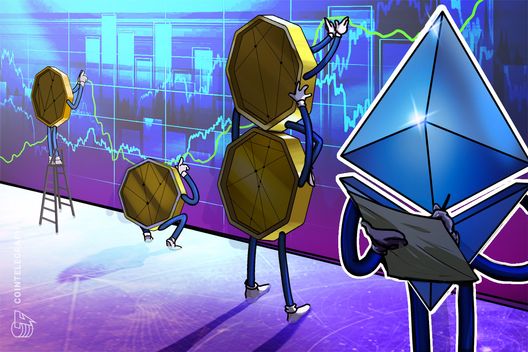The cryptocurrency world is buzzing with excitement following the recent unveiling of the “SSV 2.0” framework by the SSV DAO, the driving force behind the SSV Network’s decentralized staking protocol. Announced on Tuesday, this innovative endeavor aims to leverage Ethereum validators, paving the way for a new genre of applications dubbed “based” technology. As Ethereum developers seek to enhance interoperability and security across its expansive ecosystem, SSV 2.0 is positioned as a significant advancement in addressing the fragmentation currently affecting layer-2 networks.
“This announcement marks a transformative leap for bootstrapping Ethereum security,” the SSV team stated, highlighting the project’s potential to tackle key challenges in the Ethereum landscape.
At the core of SSV 2.0 is the concept of “based rollups,” a technology that not only enhances application interoperability but also diminishes reliance on centralized sequencers, which have been criticized for their vulnerability as single points of failure. By utilizing the robust security framework of Ethereum’s layer-1 validators, these bApps promise a more secure and resilient infrastructure.
The SSV Network’s goal is not just to innovate but also to align its operations more closely with Ethereum’s foundational principles. By securing bApps directly through the Ethereum layer-1, the SSV team is aiming to eliminate cascading risks associated with prior staking models. This shift reflects a broader commitment to fostering a decentralized environment that remains true to the ethos of Ethereum, resonating with stakeholders eager for seamless solutions in an increasingly fragmented space.
“Transforming the SSV Network from a DVT-powered staking infrastructure into a multidimensional network for the based economy will necessitate an evolution of SSV tokenomics,” they explained.
With significant funding initiatives and a clear roadmap, the SSV DAO is actively contributing to Ethereum’s ongoing decentralization and security efforts. As developments unfold, the introduction of “SSV 2.0” could very well be a game-changer for the blockchain industry, promising a future where Ethereum and its myriad applications function more harmoniously.

Key Points from SSV DAO’s Announcement on SSV 2.0
The introduction of SSV 2.0 by the SSV DAO brings significant implications for developers and users within the Ethereum ecosystem. Here are the most important aspects:
- Launch of SSV 2.0 Framework:
- Unveiled by the SSV DAO to enable decentralized staking through Ethereum validators.
- Aims to facilitate the development of “based” applications (bApps) on Ethereum.
- Based Technology:
- Enhances interoperability and security for applications utilizing Ethereum’s layer-1 validator set.
- Addresses issues of fragmentation caused by numerous layer-2 networks on Ethereum.
- Transition from Sequencers to Validators:
- Based rollups eliminate the centralization risks associated with current sequencers.
- Utilizing layer-1 validators for transaction execution improves security and reliability.
- Benefits of bApps:
- Gain direct security from layer-1 instead of relying on multiple tokens, enhancing Ethereum alignment.
- Minimizes the risks associated with existing restaking models.
- Transformation of SSV Network:
- Proposed shift from DVT-powered staking infrastructure to a multidimensional network for the based economy.
- Requires evolution of SSV tokenomics to support this transition.
- Impact on Ethereum’s Security:
- SSV 2.0 aims to bootstrap Ethereum’s security amidst increasing ecosystem fragmentation.
- Addresses the growing demand for Layer 1-anchored interoperable solutions.
“This announcement marks a transformative leap for bootstrapping Ethereum security, addressing the growing demand for Layer 1 (L1)-anchored interoperable solutions amidst increasing ecosystem fragmentation.” – SSV Team
SSV 2.0 Launch: A Game Changer for Ethereum’s Ecosystem
The recent unveiling of the SSV 2.0 framework by the SSV DAO marks a significant step forward in the quest for enhanced scalability and security on the Ethereum network. This initiative focuses on alleviating common issues associated with current layer-2 solutions by employing “based” technology that draws on Ethereum’s robust validator framework. In an ecosystem overflowing with fragmentation, SSV 2.0 may well serve as a much-needed glue, offering improved interoperability and security. However, as with any innovation, there are clear competitive advantages and disadvantages worth discussing.
One of the major competitive advantages of SSV 2.0 lies in its ability to directly utilize Ethereum’s layer-1 security. This shift away from reliance on centralized sequencers reduces the risk of single points of failure, which has been a significant concern for many Ethereum developers. Current decentralized applications often face uncertainties in transaction ordering and execution; SSV 2.0 aims to provide a more reliable, decentralized model that mitigates these risks. This is particularly beneficial for Ethereum developers and projects that are looking to enhance their applications without compromising on security, potentially paving the way for greater user trust and broader adoption.
Conversely, the transition to SSV 2.0 may pose challenges for existing layer-2 solutions that have thrived using traditional sequencer models. These platforms may find themselves at a disadvantage as the new “based” applications gain traction, leading to increased competition in the decentralized staking space. Furthermore, while the SSV Network’s move to transform its tokenomics is an ambitious endeavor, it could disrupt existing user expectations and investor confidence, particularly among those invested in the current structure of the network.
Moreover, the SSV DAO’s push to turn its network into a bApp may also create friction for projects that have already established their models on existing layer-2 systems. While the allure of interoperable solutions is undeniable, legacy applications may struggle to adapt quickly enough to the new environment, resulting in potential setbacks or loss of market share. This shift could cater to dApp developers seeking more secure and efficient ecosystems but could simultaneously alienate those firmly rooted in traditional models.
Ultimately, while SSV 2.0 stands to benefit Ethereum developers and users looking for a more seamless experience, it might create hurdles for established players in the decentralized space. The ongoing pursuit for enhanced security and interoperability highlights the need for continuous innovation within the Ethereum ecosystem, with SSV 2.0 positioning itself as a key contender in this evolving landscape.

















